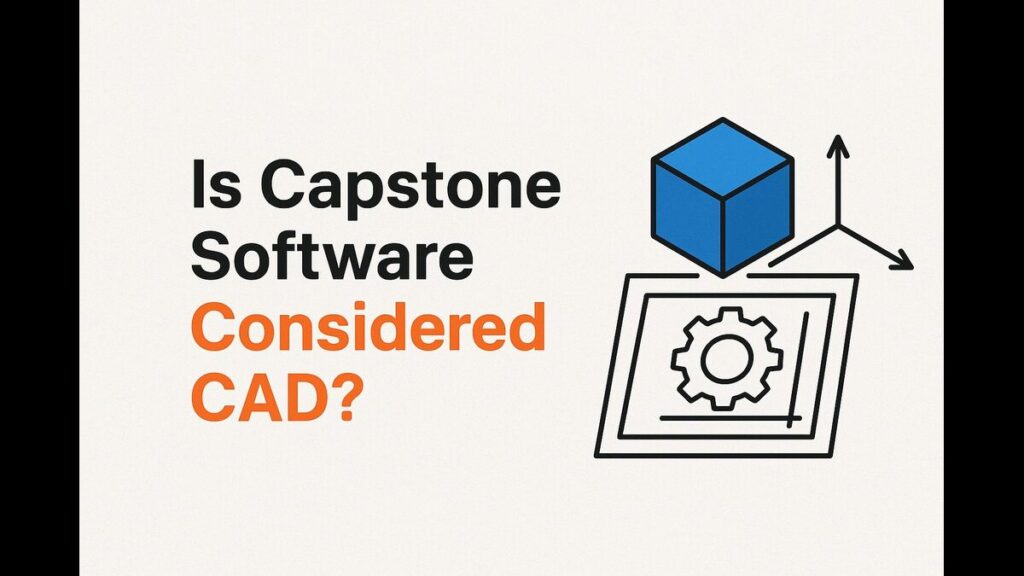Imagine you’re an engineer working on a microturbine system for a distributed energy project. You heard about Capstone software, but you stop and ask yourself, “Is Capstone Software Considered CAD? This is a common question that strikes the minds of professionals, students, and energy enthusiasts. In this blog, we’ll break down everything you need to know about Capstone software, and is it able to considered as cad.
Understanding CAD Software
Computer-aided design, or cad software, allows engineers and designers to create, edit, and visualize their designs in 2d and 3d. Popular cad tools like Autocad, Solidworks, and Fusion 360 are versatile and used by many industries, from mechanical engineering, automotive design, to architecture and consumer products.
CAD software isn’t about drawings—it’s about turning ideas into accurate, workable designs that can convert concept into reality. It provides features like geometric modeling, technical documentation, and design visualization, which are not offered by other software platforms these essential functions.
Where Capstone Software Fits In
Capstone software is a specialized tool built for the energy sector, especially for turbine and distributed energy systems. Unlike general-purpose CAD tools, it focuses on designing, simulating, and optimizing turbine systems to ensure they perform efficiently and reliably.
For example, an engineer working on a microturbine can use Capstone software to simulate how changes in components affect efficiency, visualize the system in 3d, and even predict how it will perform in the real world before building a single prototype. It’s not just about creating drawings; it’s about making sure the entire system runs efficiently and reliably.
While Capstone does include CAD-like features such as 3d modeling and technical drawings. Its real strength lies in performance analysis and system optimization. In simple words, it’s a hybrid tool: part cad, part specialized engineering simulator designed to make engineers smarter, more efficient design decisions.

Capstone software vs traditional CAD
To determine if Capstone software is considered CAD, let’s compare it with conventional CAD tools:
| feature | traditional cad | capstone software |
| 2d drafting | yes | limited |
| 3d modeling | yes | yes, turbine-focused |
| technical drawings | yes | yes, system-specific |
| simulation | limited | extensive, domain-specific |
| general-purpose design | yes | no |
| industry focus | multiple | energy generation & turbines |
As the table shows, Capstone software contains CAD-like features, but it is specialized for a specific domain. it excels at turbine system performance evaluation, but does not replace a general CAD tool for diverse engineering or architectural tasks.
Who Should Use Capstone Software?
Capstone software is ideal for engineers, system integrators, and project developers in the energy sector. Engineers can do experiment with different turbine configurations, system integrators can make sure all components fit and work together smoothly, and project developers can predict long-term performance before anything is built.
For professionals working on turbine or microturbine projects, Capstone can save weeks of trial-and-error and reduce costly mistakes. However, for general engineering, architecture, or product design, it’s best to use Capstone alongside traditional CAD tools rather than as a standalone solution.
Is Capstone Software Considered CAD?
Capstone software isn’t a full cad solution, but it does include cad-like features such as 3d modeling and technical drawings. Its primary focus is performance modeling and system optimization, which makes it best described as specialized engineering software with integrated CAD capabilities.
Within the energy and turbine sector, it can act like CAD and even outperform traditional CAD tools for certain tasks. However, outside this specialized area, it cannot replace general-purpose CAD software.
Benefits, and Real-World Applications of Capstone Software
Capstone software offers advantages for energy professionals. Instead of spending weeks testing physical prototypes, engineers can use it to simulate turbine performance in advance to save both time and money. Its optimization tools make it easier to find the most efficient system setups, so designs move from concept to reality faster and with fewer mistakes. this not only builds confidence but also helps projects avoid costly delays. capstone is especially useful in distributed energy projects, combined heat and power (chp) plants, and microgrids, where system efficiency plays a key role in long-term success.
Limitations
However, Capstone does come with some limitations. unlike general-purpose cad platforms, its focus is much narrower—mainly on turbine-based systems. this means architects, automotive engineers, or product designers may find it less useful, as it doesn’t offer the versatility of tools like autocad or solidworks. another thing to keep in mind is the learning curve. since capstone is highly specialized, new users might need some training before they can fully unlock its features and benefits.
Future
Looking ahead, Capstone has the potential to become even more powerful as the energy industry moves deeper into digital transformation. with integration of digital twins, iot sensors, and ai-driven analytics, it could deliver even sharper performance predictions and smarter system optimization. in this sense, capstone isn’t just another engineering tool—it’s shaping up to be a key part of the future of sustainable energy design.
Conclusion
Capstone software bridges the gap between regular cad tools and advanced engineering simulators. it offers cad-like features, such as 3d modeling and system drawings, but its real strength is in analyzing and optimizing turbine performance. For professionals in the energy sector, this delivers projects in short time with higher accuracy, and more accurate results.

